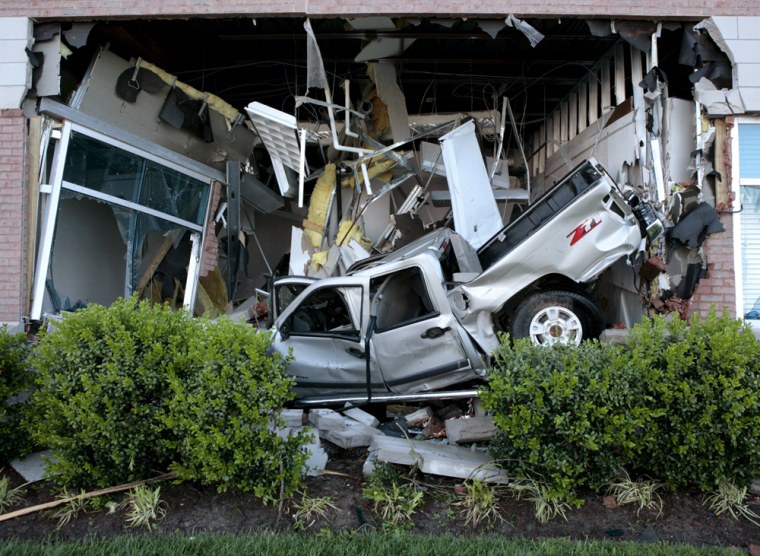Residents gathered at a school Wednesday, carrying black garbage bags and backpacks as they waited to be taken to their tornado-ravaged neighborhoods to gather necessities from their homes.
Several said they were upset that officials were allowing them only 10 minutes at their houses.
“I understand the need to make sure more people don’t get hurt but it’s still frustrating,” John Catania said.
Catania got his first look at his flattened house Wednesday, and said it “looked like somebody took a broom and swept the pad clean.”
Worried state officials had said earlier they didn’t know if residents would encounter new dangers including damaged power lines and natural gas mains.
“These guys don’t know what’s under the debris, but that’s the way it is in these situations: We like to do these things ourselves,” state emergency management spokesman Bob Spieldenner said Tuesday.
Police listed condemned homes that homeowners wouldn’t be allowed to go into Wednesday.
From the governor to the people whose homes were demolished, Virginians were amazed and grateful that a tornado that injured 200 people killed no one.
Dangers ahead
But in many ways, police and fire officials say, the worst may lie ahead. In disasters like these, Bob Spieldenner recalls, the aftermath can bring as much danger as the storm itself.
“That’s the way it was with Hurricane Isabel,” the Virginia Department of Emergency Management spokesman said, referring to the last major natural calamity to hit Suffolk, a city of 80,000 west of Norfolk.
“There were more people injured in the cleanup after Isabel than in the storm itself. We had people die of carbon monoxide (from running generators indoors), falling off roofs, falling out of trees,” he said.
In September 2003, Isabel killed 25 people in Virginia, most of them in the Tidewater region.
On Wednesday morning, some residents had the first chance to see the extent of the damage beneath the debris, a prospect that worries state officials. They don’t know if residents will find things they can salvage, or new dangers including electricity and natural gas lines.
“These guys don’t know what’s under the debris, but that’s the way it is in these situations: We like to do these things ourselves,” Spieldenner said.
How, or whether, to rebuild
Residents ordered out of their ravaged houses Monday night were horrified to see their shredded homes in Tuesday’s bright sunlight. They wept, consoled one another, and rejoiced that all were alive and accounted for. Then they began making the first difficult calculations about how — or whether — to rebuild.
Firefighters poked through mounds of rubble sometimes 6-to-8 feet high to make sure no one lay beneath them, and utility crews worked round-the-clock to make sure electricity and gas lines presented no danger.
Among those who got the first look at his destroyed home was Tom Becker, who rushed home from a vacation in Atlantic City, N.J., after the tornado. His house was barely standing and he looked wistfully inside at family portraits still hanging on an interior wall. There was no ceiling to shelter them.
“I just want to get in there and get the things that are important to me,” he said. “I know now that it’s gone.”
At least 25 debris cleanup volunteers sanctioned by Operation Blessing — a Virginia Beach-based charity funded by religious broadcaster Pat Robertson — will arrive Wednesday, said the Rev. Tony Peak, pastor of Suffolk’s nondenominational Open Door Church.
Damage estimates in flux
State and local officials were still far from a final estimate of the damages from the Suffolk twister — the worst of six the National Weather Service says hit Virginia. Losses from the lesser storms are already at least $3.5 million, Spieldenner said. In Suffolk, the destruction could be in the tens of millions of dollars.
Kaine said he was not yet certain that the damage qualifies for a presidential disaster declaration, a designation that qualifies a region for low-interest federal loans to help homeowners rebuild.
“We’ve got to survey the needs and see what can be done,” Kaine said during a walking tour of a neighborhood of houses local authorities had condemned.
“I’m going to let my guys who do this for a living tell me what the answer to that is, and it usually takes a day or two,” Kaine said.
Other hazards await from scam artists who flock to disaster sites. Con artists pose as officials or “disaster workers,” advertise job opportunities that seem too good to be true, and take money for home repairs they never perform.
Skepticism is healthy for disaster victims, said J. Tucker Martin, press secretary to Attorney General Bob McDonnell.
“Use common sense, and research the contractors and companies before spending any money,” Martin said.
